Adobe Audition CS6: I Think I'm in Love
 You may know that I have a background that includes several years of working in the broadcast industry. For that reason I'm partial to applications that make audio productions sound better and, although I've used Adobe Audition for several years, the CS6 version amazes me every time I open it. If you work with audio, either as an amateur or a professional, this is an application you should check out.
You may know that I have a background that includes several years of working in the broadcast industry. For that reason I'm partial to applications that make audio productions sound better and, although I've used Adobe Audition for several years, the CS6 version amazes me every time I open it. If you work with audio, either as an amateur or a professional, this is an application you should check out.
Here's a quick personal history of audio from my perspective: I started working for WCOL in 1966. The station's chief engineer, Tip Carpenter, had created a foolproof control room. We had an audio board with a single (or maybe 2) microphone inputs, a line for the newsroom, and 4 carts. Audio processing controlled volume so well that it was impossible to sound bad even if you tried. WCOL's 250-Watt nighttime signal sounded louder than WTVN's 5000-watt signal.
A year later, I moved to WTVN, where we still used turntables to play records. The equipment was old but the sound was good.
In 1968 I moved to Fort Wayne as assistant news director at WLYV, then to WIFE in Indianapolis, and in 1970 to WOMP in Bellaire (serving the Wheeling market). Audio editing back then was the same in large markets (Columbus or Indianapolis) as it was in small markets (Fort Wayne or Wheeling): You probably would be using a razor blade to cut audio tape and using special spicing tape to stick the pieces back together. Only at WCOL did we have equipment that allowed primitive on-the-fly edits.
After being away from radio for a couple of decades, I found myself back at WTVN in the 1980s. Everything was still based on magnetic tape but by the mid 1990s electronic editing had been added. The hardware and software in those days was primitive but it was still exciting. We could eliminate mistakes with just a few mouse clicks and key strokes. By 2006 when I left the broadcast industry for good, digital editing and digital content were the rule, not the exception.
But when I think of WTVN's digital audio workstations I remember systems that were hard to use, slow, cumbersome, and expensive. By contrast, Adobe Audition is easy to use, fast, lithe, and surprisingly inexpensive. Those old dedicated audio workstations cost more than $10,000 and did nothing but audio editing. Audition is simply an application that's installed on your desktop computer. If you add the cost of Audition to the cost of the computer, you'll probably pay less than $2000.
The First Look
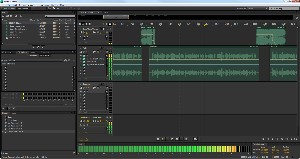 At first glance, you might think that nothing much has changed between CS3 and CS6 but first glances can be deceiving. You may know that Audition came to Adobe when the company acquired Cool Edit Pro version 2.1 from Syntrillium Software. Cool Edit 2 was a powerful editing program that was a good addition to the Creative Suite.
At first glance, you might think that nothing much has changed between CS3 and CS6 but first glances can be deceiving. You may know that Audition came to Adobe when the company acquired Cool Edit Pro version 2.1 from Syntrillium Software. Cool Edit 2 was a powerful editing program that was a good addition to the Creative Suite.
In the years since 2003, Adobe's software engineers appear to have rewritten the entire application and the result is a real powerhouse. This is the default workspace.
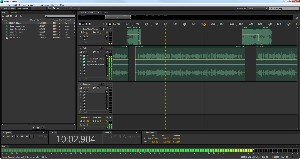 For those who really like the older interface, Adobe has provided it.
For those who really like the older interface, Adobe has provided it.
There are specific workspaces for editing audio that is part of a video track, for mastering and analysis, for radio production (including the ability to add data that's essential to radio station automation), and even a setup that's optimized 2 screens. But no matter where you start, you can modify the interface colors, keyboard shortcuts, and the positioning of any component. Once you've done that, you can save the workspace under a new name for future use.
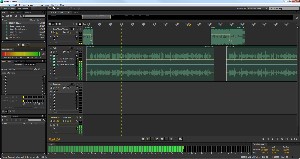 This is the radio production setup.
This is the radio production setup.
Audition has 2 primary types of workspaces, Waveform (single track) and Multitrack (where you mix multiple tracks together). Edits made in the Waveform mode are destructive, meaning that if you cut out a chunk of audio, the audio is gone. In the Multitrack setup, most of the changes you make are non-destructive, meaning that you can go back later in the session, next day, or next year, and undo anything you've done.
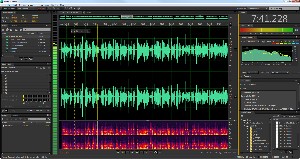 Most work starts in the Waveform view. Here's where the track can be prepared for use. Mistakes can be edited away and noises can be attenuated.
Most work starts in the Waveform view. Here's where the track can be prepared for use. Mistakes can be edited away and noises can be attenuated.
The top part of the screen shows a traditional oscilloscope view of the track and anyone who has ever worked with audio will instantly recognize this view. The view can be expanded to show individual samples (that could be 40,000 samples per second or more so there's rarely a need to edit at that magnification). The waveform makes editing easy because, with a little experience, you can almost see the words on the track.
But you may be wondering about that section at the bottom. That's the Spectral Frequency Display. Lower frequency sounds are at the bottom and higher frequencies are at the top. The loudest sounds are bright yellow and absolute quiet is black. This display makes certain kinds of harsh noises (clicks, pops, ringing phones) stand out. And when you can see the problem sound, the magic begins.
Audition includes a healing brush that works the same way the healing brush works in Photoshop, except it performs its magic on sounds. Paint over the problem sound and Audition will do its best to eliminate the noise and leave behind an inaudible patch. Additionally, you'll find other selection tools that you can try if the healing brush doesn't do what you want it to.
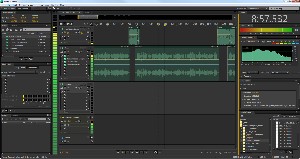 Here's the Multitrack view. I don't use a lot of tracks. The top track is where the intro, outro, and bumpers (music between the sections) will be placed. The second channel is where my voice track lives and it is affected by a compressor, a reverb setup, and an equalizer. The next level down is where any interviews or other audio will appear. Below that you'll see the Reverb and Compression buss and, at the bottom, the master channel.
Here's the Multitrack view. I don't use a lot of tracks. The top track is where the intro, outro, and bumpers (music between the sections) will be placed. The second channel is where my voice track lives and it is affected by a compressor, a reverb setup, and an equalizer. The next level down is where any interviews or other audio will appear. Below that you'll see the Reverb and Compression buss and, at the bottom, the master channel.
Improving the Audio
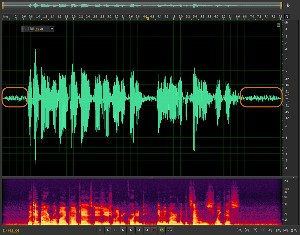 The conditions under which TechByter Worldwide is recorded aren't exactly the best possible conditions for quality audio. Although I like the microphone I'm using, it does produce a noticeable low-frequency hum and, because of fans in the room, the environment is noisy. You'll hear that in the short audio track.
The conditions under which TechByter Worldwide is recorded aren't exactly the best possible conditions for quality audio. Although I like the microphone I'm using, it does produce a noticeable low-frequency hum and, because of fans in the room, the environment is noisy. You'll hear that in the short audio track.
You can see the noise clearly at the beginning and end of the track.
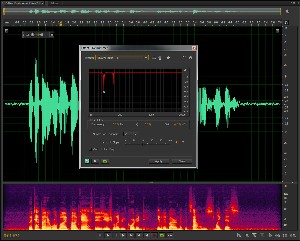 The first action to take is to attenuate the low-frequency hum. Here I've added a notch filter at 60Hz and the second harmonic. The filter is centered on 60Hz and I'm dropping the gain by 40dB.
The first action to take is to attenuate the low-frequency hum. Here I've added a notch filter at 60Hz and the second harmonic. The filter is centered on 60Hz and I'm dropping the gain by 40dB.
The shape of the noise has changed visibly before and after the audio. Now it's time to get rid of the rest of the room noise.
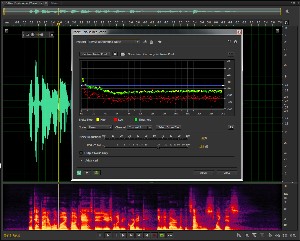 The fans produce quite a bit of room noise but getting rid of it is relatively easy. After showing Audition what the noise looks like by selecting a part of the track without my voice, I call up the Noise Reduction filter.
The fans produce quite a bit of room noise but getting rid of it is relatively easy. After showing Audition what the noise looks like by selecting a part of the track without my voice, I call up the Noise Reduction filter.
Any changes Audition makes will be based on its analysis of the noise. Because the noise is strong, I selected an aggressive filter setting to reduce the amount of noise by nearly 90% and to pull the noise down by about 20dB. That's enough to all but vanquish the noise without adversely affecting the voice.
A common problem is broadcast is having an audio clip that 57 seconds or 64 second long when you need 60. Audition includes tools that can easily fix problems like that. I decided to give Audition a severe challenge to work with: A 7-second clip that needs to be 10 seconds.
That requires some explanation because you may be thinking "That's only 3 seconds so what's the big deal?" The big deal is that 10 seconds is 42% longer than 7 seconds. In other words, I need to add nearly 50% to the time line? That's the equivalent of stretching a program that's about 40 minutes long to a full hour! Maybe now it doesn't seem so trivial.
You'll notice that the clip that I say is 10 seconds long is really 11 seconds. That's because I need 1 second of silence at the beginning of each clip to keep the player mechanism from playing the first big of the audio file when the page loads. Time the audio and you'll see that the beginning track is 7 second and the ending track is 10 seconds.
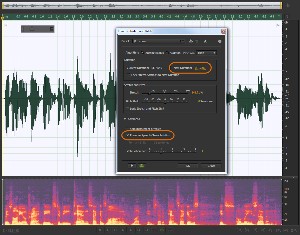 Here's where I started.
Here's where I started.
Then, I specified that the final track should be 10 seconds long and that Audition should do its best to preserve speech characteristics. Here's my 42% longer version:
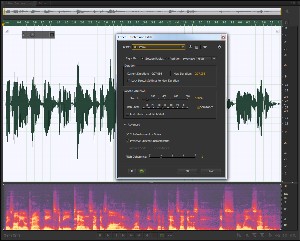 Then, just for my own amusement, I thought I'd see what I could do to move my voice to a lower register and see if I could impersonate one of those "Voice of God" announcers you sometimes hear on the radio.
Then, just for my own amusement, I thought I'd see what I could do to move my voice to a lower register and see if I could impersonate one of those "Voice of God" announcers you sometimes hear on the radio.
Nope. Not even with Audition's help.
More Magic
In the old days, edits weren't reversible. Once you cut the tape, let the part you no longer wanted fall to the floor, and used splicing tape to put the remaining pieces back together, that was it. If it was wrong, it was wrong and it would stay wrong. That's not quite entirely true, but correcting a bad edit was difficult at best and there was no guarantee of success.
Applications such as Audition improved things considerably with "undo". If the edit was bad, just click Ctrl-Z and move the edit points. You might have to do this several times but eventually you'd get it right. But Audition CS6 offers a new feature called Skip Selection playback and here's how it works: After selecting the start point and the end point for your edit, select Skip Selection and play the track. If you like what you hear, commit the edit; if not, move the end points and try again.
If you want to see some of the real magic, check out the 5 minute video by Adobe Senior Solutions Consultant Colin Smith who explains how the the new Auto Speech Alignment feature works.

 If You Work with Audio and You Delay Upgrading to Audition CS6, You Will Regret It
If You Work with Audio and You Delay Upgrading to Audition CS6, You Will Regret It
Audition CS6 is one of those programs that earns 5 cats only because I have no more cats to award. This version deserves 15 cats and a basket full of kittens. There are so many powerful features in Audition for so many different kinds of users that no review could ever hope to do justice to them all.
For more information, visit the Adobe Audition website.
Dwolla Isn't Exactly PayPal (or Your Bank) But That's OK
Dwolla is an Iowa startup mobile cash network that connects to your social community in a way that allows you to spend money or send money to others from your bank account. The recipient pays only 25 cents per transaction, no matter how high the transfer amount. Dwolla uses proprietary technology and has business partnerships with the Veridian Group and The Members Group. You might want to learn more about this.
Dwolla is based in the heart of what the company calls the "Silicon Prairie", Des Moines, Iowa. Unlike traditional payment networks, Dwolla takes the industry in a new direction by allowing people for the first time to share money with their social networking contacts and their phone. Building products like FiSync, a service that provides banks with the ability to do real-time ACH transfers has put Dwolla at the center of technological innovation in the payments and financial industry.
So let's start with what an ACH transfer is. Automated Clearing House (ACH) is an electronic network for financial transactions in the United States the system processes credit and debit transactions in batches, including direct-deposit payroll and vendor payments. ACH direct debit transfers include consumer payments on insurance premiums, mortgage loans, and other kinds of bills. Debit transfers also include new applications such as the point-of-purchase (POP) check conversion pilot program sponsored by NACHA, formerly the National Automated Clearing House Association, but now known as the Electronic Payments Association. Both the government and the commercial sectors use ACH payments. If you're interested in the details and some examples of how it works, Wikipedia has a long article about the process.
Dwolla's fees are astonishingly low. The organization's website says "with Dwolla there are never any hidden fees, 'gotcha' moments, or the irresponsible use of your private information. We're dedicated to building smarter technologies to create smarter decision-makers." The cost of sending a payment is $0.00. The cost of sending a request for money is $0.00. The cost to receive a payment that is less than $10 is $0.00. But the cost to receive a payment that is more than $10 is $0.25. That's right, a quarter. Twenty-five cents. Whether the payment is $12, $1200, or $12,000. There's also no fee to open an account or to attach a bank account to Dwolla (actually the confirmation process pays you a few cents to attach a bank account to Dwolla). There's no fee for automatic or manual withdrawals or for just about anything else. If you choose to participate in "Dwolla Instant" there is a monthly $3 fee.
"Dwolla Instant" is an opt-in feature that provides instant access to payments instead of the usual several-day waiting period. When you turn the feature on, you can deposit and send cash without delay. Instant transactions are still 25 cents, except for those under $10, which are free. The only cost is the $3 monthly fee and a $5 "late fee" if you fail to bring a negative balance back to zero or above by the day Dwolla issues your monthly statement.
Currently Dwolla is available only for users in the United States. For more information, see the Dwolla website.
Short Circuits
Room Service. Would You Like Some Malware with Your Room?
A report that's so vague that it almost sounds phony has been issued the the Internet Crime Complaint Center (IC3) but because the IC3 is a partnership between the Federal Bureau of Investigation (FBI) and the National White Collar Crime Center (NW3C) and because it is funded in part by the Bureau of Justice Assistance (BJA), you have to give it some credence. The IC3 says that you might encounter malicious pop-up windows that look like legitimate upgrade messages while connecting to the Internet from a hotel room.
The threat apparently is more severe outside the United States but it could happen anywhere. The IC3 describes the infection process this way: A traveler who is attempting to establish a connection via the hotel's network is presented a pop-up window notifying the user to update a widely-used software product. If the user then clicks to accept and install the update, malicious software was installed. "The pop-up window appeared to be offering a routine update to a legitimate software product for which updates are frequently available."
Could they be any more vague? Lots of applications have frequent updates. It's hard to start a computer these days without having something tell you that it needs to be upgraded.
The FBI recommends common sense but the IC3 expands on that a bit: "The FBI recommends that all government, private industry, and academic personnel who travel abroad take extra caution before updating software products on their hotel Internet connection. Checking the author or digital certificate of any prompted update to see if it corresponds to the software vendor may reveal an attempted attack. The FBI also recommends that travelers perform software updates on laptops immediately before traveling, and that they download software updates directly from the software vendor’s Web site if updates are necessary while abroad."
I can state that a bit more succinctly: If you're offered an update when you're connecting to or when you're connected to a network other than the one in your home or office, don't accept it.
If you'd like more vague information visit the IC3 website.
Four Months and Counting
If you're anxiously awaiting Windows 8, you have about 4 months to wait. And if you're dreading the arrival of Windows 8, you have about 4 months to wait. Microsoft says Windows 8 and its new Surface tablet computers will be available in October. Last week I mentioned the upgrade price for Windows 8—$40 or $70 if you don't want to use the online upgrade. The Surface tablets are expected to sell for around $500 (for the basic version) and $1000 for a more powerful tablet.
When in October? Microsoft hasn't said but the company clearly wants to have the new operating system available in time for the holiday shopping season. Windows 8 is the most radical change in Windows since 1995.
Those who are used to desktop systems will have to deal with changes that are perceived as monumental. Those perceptions, in my estimation, are wrong. Yes, there are changes but it seems to me that the advantages of having an operating system that looks very much the same on a phone, a tablet, a notebook, a desktop, and a server outweigh the difficulties of dealing with what is in reality an interface change that appears to be enormous while actually being inconsequential once you've used Windows 8 for more than a day.
Ubuntu Linux Seemed Like Such a Good Idea
Because I've been dual-booting most of my computers between Windows 7 and Windows 8, I haven't had much time to look at Ubuntu Linux for the past year or so. With the advent of Windows 8, I was beginning to look forward to dual-booting Linux and Windows 8. Now I'm not so sure.
Linux is still installed on a netbook computer that also runs Windows 7. This week, because version 12.4 has been out for a while, I thought I'd upgrade the Linux installation. That turned out to be a bad idea.
The process started normally. When I booted to Linux, the system told me that an update (to Precise Pangolin) was available. I selected the update option and the process stalled after about 10 minutes.
Then I restarted the update process and the computer claimed to lose its Internet connection about an hour later, after it had downloaded most of the files required to remove 30 packages, add 292 packages, and update 1606 packages (total download a little over 1GB). So I took the netbook home and tried again.
This time the process ran normally for about an hour and then crashed. Badly.
On reboot, I could select Linux from the GRUB (grand unified boot manager) but Linux never started.
Windows would still boot so I opened the disk manager, deleted the Ubuntu partition, expanded the Windows boot volume to take over the space vacated by Ubuntu and rebooted. GRUB is still active and still offers Ubuntu as an option. I'll resolve that little glitch when I get around to it but for now I have a netbook that runs Windows and that's all I need.
Linux has never been much more than a toy for me anyway because applications I depend on, particularly those from Adobe, simply aren't available for Linux.
A Personal Message from God Allah (Which is Redundant)
This would have been a great public relations stunt when George Burns was making movies as god. Friday morning I received an e-mail from god allah asking if I knew of a church of mosque (etc) in the US to receive him. If so, I was asked to e-mail, call, or text message god allah or visit his website.
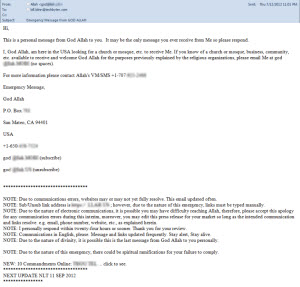 That's the message at the right. Click it for a full-size view.
That's the message at the right. Click it for a full-size view.
God allah seems not to be particularly powerful because he seems to be incapable of finding a church or mosque (etc) that would welcome him and even god allah apparently cannot deal successfully with the Internet Corporation for Assigned Names and Numbers (ICANN) because he says, "Due to communications errors, websites may or may not yet fully resolve." God allah also says that communications must be in English only and warns, "Due to the nature of divinity, it is possible this is the last message from God Allah to you personally," and "Due to the nature of this emergency, there could be spiritual ramifications for your failure to comply."
God allah sure likes the words "due to" doesn't he?
The message promises an update before September 11 so it's hard to determine what to make of the message — somebody's idea of a sick practical joke? A link to a poisoned website? Just an ordinary spam? It's anybody's guess but I can tell you this: I'm not going to follow the link and I've obscured all of the links so that nobody else can be harmed accidentally.



 The author's image: It's that photo over at the right. This explains why TechByter Worldwide was never on television, doesn't it?
The author's image: It's that photo over at the right. This explains why TechByter Worldwide was never on television, doesn't it?
